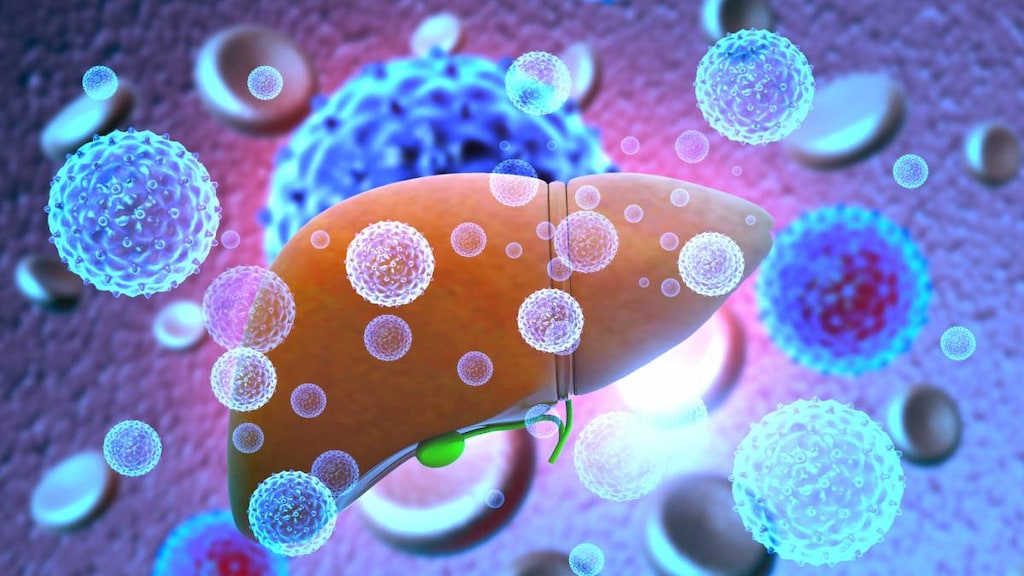Boxed Warning
Post-treatment severe acute exacerbation of hepatitis B:
Discontinuation of anti-hepatitis B therapy, including tenofovir alafenamide, may result in severe acute exacerbations of hepatitis B. Hepatic function should be monitored closely with both clinical and laboratory follow-up for at least several months in patients who discontinue anti-hepatitis B therapy, including tenofovir alafenamide. If appropriate, resumption of anti-hepatitis B therapy may be warranted.
Dosage Forms
Excipient information presented when available (limited, particularly for generics); consult specific product labeling.
Tablet, Oral:
Vemlidy: 25 mg
Pharmacology
Mechanism of Action
Tenofovir alafenamide, an analog of adenosine 5'-monophosphate, is converted intracellularly by hydrolysis to tenofovir and subsequently phosphorylated to the active tenofovir diphosphate. The active moiety inhibits replication of HBV by inhibiting HBV polymerase.
Pharmacokinetics/Pharmacodynamics
Metabolism
Tenofovir alafenamide (TAF) is converted intracellularly by hydrolysis to tenofovir, then phosphorylated to the active tenofovir diphosphate.
Excretion
Feces (31.7%) and urine (<1%)
Time to Peak
Serum: 0.48 hours
Half-Life Elimination
Serum: 0.51 hours
Protein Binding
80% to plasma proteins
Use: Labeled Indications
Chronic hepatitis B: Treatment of chronic hepatitis B virus (HBV) infection in adults with compensated liver disease
Contraindications
There are no contraindications listed in the US manufacturer's labeling.
Canadian labeling: Additional contraindications (not in US labeling): Hypersensitivity to tenofovir alafenamide or any component of the formulation
Dosage and Administration
Dosing: Adult
Chronic hepatitis B: Oral: 25 mg once daily
Dosing: Geriatric
Refer to adult dosing.
Administration
Oral: Administer with food.
Storage
Store below 30°C (86°F). Dispense in original container.
Drug Interactions
Acyclovir-Valacyclovir: May increase the serum concentration of Tenofovir Products. Tenofovir Products may increase the serum concentration of Acyclovir-Valacyclovir. Monitor therapy
Adefovir: May diminish the therapeutic effect of Tenofovir Products. Adefovir may increase the serum concentration of Tenofovir Products. Tenofovir Products may increase the serum concentration of Adefovir. Avoid combination
Aminoglycosides: May increase the serum concentration of Tenofovir Products. Tenofovir Products may increase the serum concentration of Aminoglycosides. Monitor therapy
Cabozantinib: MRP2 Inhibitors may increase the serum concentration of Cabozantinib. Monitor therapy
CarBAMazepine: May decrease the serum concentration of Tenofovir Alafenamide. Avoid combination
Cidofovir: May increase the serum concentration of Tenofovir Products. Tenofovir Products may increase the serum concentration of Cidofovir. Monitor therapy
Cladribine: Agents that Undergo Intracellular Phosphorylation may diminish the therapeutic effect of Cladribine. Avoid combination
Cobicistat: May enhance the adverse/toxic effect of Tenofovir Products. More specifically, cobicistat may impair proper tenofovir monitoring and dosing. Monitor therapy
Diclofenac (Systemic): May enhance the nephrotoxic effect of Tenofovir Products. Management: Seek alternatives to this combination whenever possible. Avoid use of tenofovir with multiple NSAIDs or any NSAID given at a high dose. Consider therapy modification
Fosphenytoin-Phenytoin: May decrease the serum concentration of Tenofovir Alafenamide. Avoid combination
Ganciclovir-Valganciclovir: Tenofovir Products may increase the serum concentration of Ganciclovir-Valganciclovir. Ganciclovir-Valganciclovir may increase the serum concentration of Tenofovir Products. Monitor therapy
Nonsteroidal Anti-Inflammatory Agents: May enhance the nephrotoxic effect of Tenofovir Products. Management: Seek alternatives to these combinations whenever possible. Avoid use of tenofovir with multiple NSAIDs or any NSAID given at a high dose. Consider therapy modification
Orlistat: May decrease the serum concentration of Antiretroviral Agents. Monitor therapy
OXcarbazepine: May decrease the serum concentration of Tenofovir Alafenamide. Avoid combination
PHENobarbital: May decrease the serum concentration of Tenofovir Alafenamide. Avoid combination
Primidone: May decrease the serum concentration of Tenofovir Alafenamide. Avoid combination
Rifabutin: May decrease the serum concentration of Tenofovir Alafenamide. Avoid combination
RifAMPin: May decrease the serum concentration of Tenofovir Alafenamide. Avoid combination
Rifapentine: May decrease the serum concentration of Tenofovir Alafenamide. Avoid combination
Sofosbuvir: May increase the serum concentration of Tenofovir Alafenamide. Monitor therapy
St John's Wort: May decrease the serum concentration of Tenofovir Alafenamide. Avoid combination
Tipranavir: May decrease the serum concentration of Tenofovir Alafenamide. Avoid combination
Adverse Reactions
>10%:
Central nervous system: Headache (12%)
Neuromuscular & skeletal: Decreased bone mineral density (5% to 11%)
1% to 10%:
Cardiovascular: Increased serum creatine kinase (grades 3/4: 3%)
Central nervous system: Fatigue (6%)
Dermatologic: Skin rash (<5%)
Endocrine & metabolic: Increased LDL cholesterol (grades 3/4: 6%), glycosuria (grades 3/4: 5%), increased amylase (grades 3/4: 3%)
Gastrointestinal: Abdominal pain (9%), nausea (6%), diarrhea (5%), dyspepsia (5%), flatulence (<5%), vomiting (<5%)
Hepatic: Increased serum alanine aminotransferase (grades 3/4: 8%), increased serum aspartate aminotransferase (grades 3/4: 3%)
Neuromuscular & skeletal: Back pain (6%), arthralgia (5%)
Respiratory: Cough (8%)
<1%, postmarketing, and/or case reports: Angioedema, urticaria
Warnings/Precautions
Concerns related to adverse effects:
- Lactic acidosis/hepatomegaly: Lactic acidosis and severe hepatomegaly with steatosis, sometimes fatal, have been reported with the use of nucleoside analogs, alone or in combination with other antiretrovirals. Suspend treatment in any patient who develops clinical or laboratory findings suggestive of lactic acidosis or pronounced hepatotoxicity (marked transaminase elevation may/may not accompany hepatomegaly and steatosis).
Disease-related concerns:
- Hepatic impairment: Use is not recommended in patients with Child-Pugh class B or C hepatic impairment.
- Hepatitis B acute exacerbation: [US Boxed Warning]: Discontinuation of anti-hepatitis B therapy may result in severe acute exacerbations of hepatitis B. Monitor clinical and laboratory data closely for several months after treatment discontinuation. If clinically indicated, anti-hepatitis B therapy may be resumed.
- HIV-1 and HBV coinfection: Should not be used as a single agent for the treatment of HIV-1 due to resistance development risk.
- Renal impairment: Use is not recommended in patients with CrCl <15 mL/minute who are not receiving hemodialysis.
- Renal toxicity: Cases of acute renal failure and/or Fanconi syndrome have been reported with use of tenofovir prodrugs; patients with preexisting renal impairment and those taking nephrotoxic agents (including NSAIDs) are at increased risk. Prior to initiation of therapy and during therapy, assess serum creatinine, estimated CrCl, urine protein, and urine glucose in all patients as clinically appropriate; also assess serum phosphorus in patients with chronic kidney disease. Discontinue therapy in patients that develop clinically significant decreases in renal function or evidence of Fanconi syndrome.
Concurrent drug therapy issues:
- Drug-drug interactions: Potentially significant interactions may exist, requiring dose or frequency adjustment, additional monitoring, and/or selection of alternative therapy. Consult drug interactions database for more detailed information.
Other warnings/precautions:
- HIV testing: HIV antibody testing should be offered to all HBV infected patients prior to treatment initiation. If HIV testing is positive, institute an appropriate antiretroviral (HIV-1) combination regimen.
Monitoring Parameters
Serum creatinine, serum phosphorus (in patients with chronic kidney disease), urine glucose, urine protein (prior to initiation and as clinically indicated during therapy); HIV testing (prior to initiation); hepatic function tests; monitor clinical and laboratory data closely for several months following therapy discontinuation.
Pregnancy
Pregnancy Considerations
Tenofovir alafenamide has a low level of transfer across the human placenta.
Data collected by the antiretroviral registry related to the use of tenofovir alafenamide in pregnancy are insufficient to evaluate teratogenicity.
Maternal antiretroviral therapy (ART) may be associated with adverse pregnancy outcomes, including preterm delivery, stillbirth, low birth weight, and small-for-gestational-age infants. Actual risks may be influenced by maternal factors such as disease severity, gestational age at initiation of therapy, and specific ART regimen; therefore, close fetal monitoring is recommended. Because there is clear benefit to appropriate treatment, maternal ART should not be withheld due to concerns for adverse neonatal outcomes. Long-term follow-up is recommended for all infants exposed to antiretroviral medications; children without HIV but who were exposed to ART in utero and develop significant organ system abnormalities of unknown etiology (particularly of the CNS or heart) should be evaluated for potential mitochondrial dysfunction. Cases of lactic acidosis and hepatic steatosis have been reported in pregnant women with use of nucleoside reverse transcriptase inhibitors.
The Health and Human Services perinatal HIV guidelines note the safety and pharmacokinetic data of tenofovir alafenamide are insufficient to recommend initiation in pregnant females living with HIV who are antiretroviral naive, who have had ART therapy in the past but are restarting, who require a new ART regimen (due to poor tolerance or poor virologic response of current regimen), and who are not yet pregnant but are trying to conceive. However, females who become pregnant while taking tenofovir alafenamide may continue if viral suppression is effective and the regimen is well tolerated. Pharmacokinetics of tenofovir alafenamide are not significantly altered during pregnancy; dose adjustments are not needed.
Females coinfected with HIV and hepatitis B virus who are taking tenofovir alafenamide prior to pregnancy and are virally suppressed should be offered a choice to switch to tenofovir disoproxil fumarate or continue with the current regimen.
In general, ART is recommended for all pregnant females living with HIV to keep the viral load below the limit of detection and reduce the risk of perinatal transmission. Therapy should be individualized following a discussion of the potential risks and benefits of treatment during pregnancy. Monitoring of pregnant females is more frequent than in nonpregnant adults. ART should be continued postpartum for all females living with HIV and can be modified after delivery.
Health care providers are encouraged to enroll pregnant females exposed to antiretroviral medications as early in pregnancy as possible in the Antiretroviral Pregnancy Registry (1-800-258-4263 or www.APRegistry.com). Health care providers caring for pregnant females living with HIV and their infants may contact the National Perinatal HIV Hotline (888-448-8765) for clinical consultation (HHS [perinatal] 2019).
Patient Education
What is this drug used for?
- It is used to treat hepatitis B infection.
Frequently reported side effects of this drug
- Headache
- Abdominal pain
- Heartburn
- Loss of strength and energy
- Cough
- Nausea
- Back pain
- Joint pain
- Diarrhea
Other side effects of this drug: Talk with your doctor right away if you have any of these signs of:
- Kidney problems like unable to pass urine, blood in the urine, change in amount of urine passed, or weight gain.
- Liver problems like dark urine, fatigue, lack of appetite, nausea, abdominal pain, light-colored stools, vomiting, or yellow skin.
- Lactic acidosis like fast breathing, fast heartbeat, abnormal heartbeat, vomiting, fatigue, shortness of breath, severe loss of strength and energy, severe dizziness, feeling cold, or muscle pain or cramps.
- Signs of a significant reaction like wheezing; chest tightness; fever; itching; bad cough; blue skin color; seizures; or swelling of face, lips, tongue, or throat.
Note: This is not a comprehensive list of all side effects. Talk to your doctor if you have questions.
Consumer Information Use and Disclaimer: This information should not be used to decide whether or not to take this medicine or any other medicine. Only the healthcare provider has the knowledge and training to decide which medicines are right for a specific patient. This information does not endorse any medicine as safe, effective, or approved for treating any patient or health condition. This is only a brief summary of general information about this medicine. It does NOT include all information about the possible uses, directions, warnings, precautions, interactions, adverse effects, or risks that may apply to this medicine. This information is not specific medical advice and does not replace information you receive from the healthcare provider. You must talk with the healthcare provider for complete information about the risks and benefits of using this medicine.



